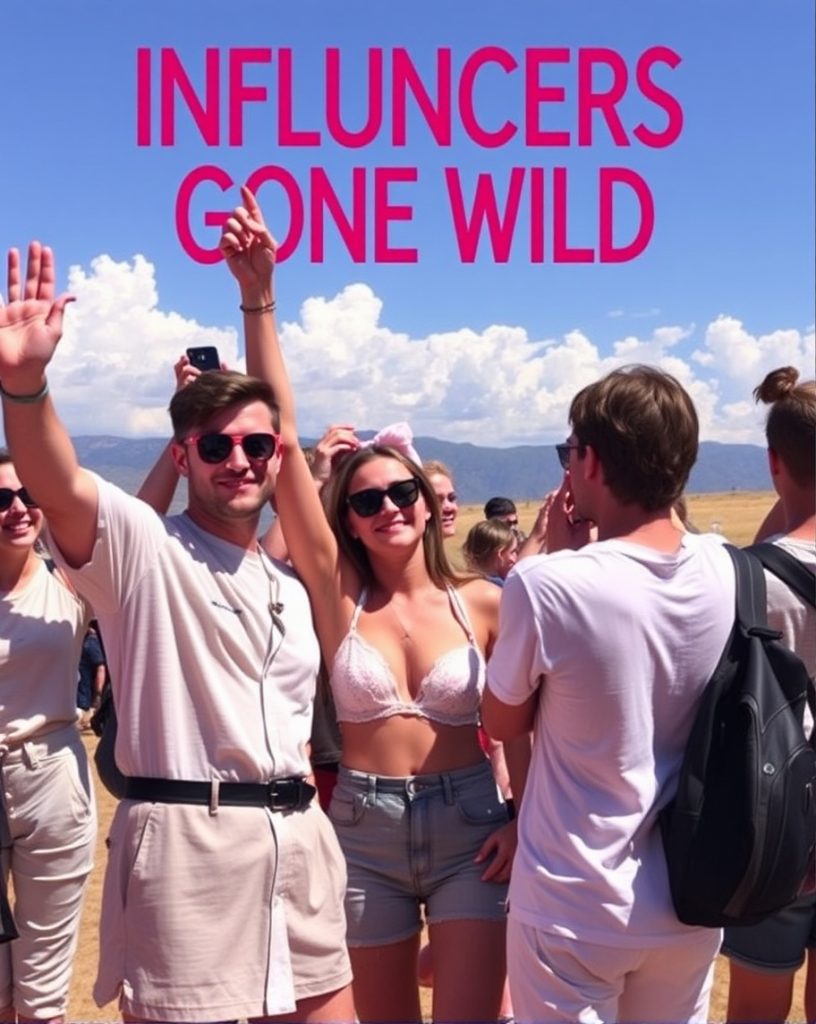Over the last decade, social media influencers gone wild have skyrocketed from obscurity to become modern-day celebrities, commanding vast audiences, lucrative brand deals, and even political influence. With the power to shape trends, lifestyles, and opinions, these digital creators have transformed the landscape of marketing, media, and culture. However, with such immense influence comes an equally immense potential for chaos. “Influencers Gone Wild” is not just a catchphrase; it’s a phenomenon highlighting the pitfalls of stardom in the social media age. From outrageous stunts to public meltdowns, scandals, and unethical behavior, the world of influencers has seen its fair share of wild moments.
The Rise of the Influencer
Before we delve into the controversies, it’s important to understand how influencers came to hold such sway. The emergence of platforms like Instagram, YouTube, and TikTok democratized fame. Unlike traditional celebrities who gained recognition through film, music, or sports, influencers built their followings organically, often sharing relatable content about their daily lives. Their appeal lies in their perceived authenticity and connection with their audience.
Social media platforms provided a level playing field for anyone with a smartphone and an internet connection. Influencers created niche content, ranging from beauty tutorials and fitness advice to cooking recipes and travel vlogs. Over time, these personalities amassed millions of followers who trusted their recommendations and aspired to their seemingly glamorous lifestyles.
Yet, with great power comes great responsibility—or at least it should. The lack of regulation and the pursuit of fame and fortune have led many influencers to push boundaries, sometimes with disastrous consequences.
Outrageous Stunts for Fame
One of the most common themes in the “Influencers Gone Wild” saga is the outrageous stunt. In the pursuit of likes, views, and engagement, many influencers have crossed ethical lines, staged dangerous activities, and put themselves or others at risk. The psychology behind this behavior is tied to the ever-growing need for attention and the pressure to keep content fresh and exciting.
The Prank Gone Wrong
In 2019, a YouTube couple known for their prank videos went viral for all the wrong reasons. Their channel, which featured elaborate practical jokes, took a dark turn when they decided to perform a “trust test” involving a blindfold and a dangerous ledge. The video ended in a tragic accident, raising questions about the lengths influencers will go to for content and the lack of oversight on social media platforms.
Pranks, while seemingly harmless, often escalate in severity as creators seek to outdo each other. The line between humor and harm becomes blurred, resulting in a cascade of irresponsible and reckless behavior. The desire to shock audiences for clicks can lead influencers down a path of poor decision-making, often with little regard for the consequences.
The Ice Cream Licker
In 2019, a viral video showed an influencer in a grocery store opening a tub of ice cream, licking it, and placing it back on the shelf. The stunt, while intended as a joke, sparked outrage and led to legal consequences. This incident highlighted the broader issue of influencers behaving irresponsibly for virality, undermining public trust and safety.
Fake It Till You Make It: The Culture of Deception
The pressure to maintain an image of perfection has given rise to another troubling trend among influencers: deception. Social media is often criticized for promoting unrealistic standards of beauty, success, and lifestyle. Many influencers have been caught fabricating elements of their lives, from photoshopped images and rented luxury cars to misleading endorsements and fake giveaways.
The Fyre Festival Fiasco
Perhaps the most infamous example of influencer deception is the Fyre Festival. In 2017, social media influencers, including major celebrities, were paid to promote what was promised to be a luxury music festival in the Bahamas. The reality, however, was a disaster: attendees arrived to find unfinished accommodations, lack of food, and chaotic organization. The event’s failure became a global scandal, shedding light on the deceptive practices used to market the festival. Influencers faced backlash for endorsing a product they knew little about, and the incident sparked a conversation about the ethical responsibilities of influencers in advertising.
Filter Failures
Many influencers heavily edit their photos, using filters and photo-editing software to enhance their appearance. While this practice is widespread, it can backfire spectacularly when the unedited reality is exposed. In several instances, influencers have been caught posting drastically altered photos that don’t match candid or live-streamed images. This discrepancy has fueled debates about the damaging effects of promoting unrealistic beauty standards and the mental health implications for both influencers and their followers.
The Pressure Cooker of Influencer Culture
The nature of social media fame can create a pressure cooker environment for influencers. The need to constantly post content, maintain a perfect image, and keep up with trends can take a significant toll on mental health. Burnout, anxiety, and depression are common, often leading to erratic behavior that ends up playing out in the public eye.
Public Meltdowns
There have been numerous instances of influencers having public breakdowns on live streams or in posts. Whether due to exhaustion, the stress of constant scrutiny, or the realization that their online persona does not align with their real life, these moments reveal the darker side of influencer culture. The facade of a perfect life can crack under the weight of unrelenting expectations, leading to explosive outbursts or concerning behavior.
One notable example is a beauty influencer who, after years of maintaining a bubbly and upbeat persona, broke down in tears during a live video, admitting to the pressure of constantly needing to be “on” and the toll it was taking on her mental health. Her candid admission sparked a wave of support but also highlighted the often-hidden mental health struggles faced by those in the public eye.
The Dark Side of Influence: Scandals and Crimes
In some cases, influencers have gone beyond questionable stunts and into outright illegal or unethical behavior. From financial fraud and scamming their followers to engaging in predatory behavior, there is a growing list of incidents where influencers have abused their platform and trust.
Influencer Scams
In 2021, a fitness influencer with millions of followers was exposed for running a fraudulent “coaching” scheme, charging clients for personalized fitness plans that turned out to be generic templates. The backlash was swift, with fans feeling betrayed by someone they had admired and trusted. This case is one of many where influencers have used their platform to exploit their followers for financial gain, highlighting the need for greater accountability and transparency in the industry.
The Crypto Pump-and-Dump
Another common scam involves influencers promoting dubious cryptocurrency projects. In several high-profile cases, influencers have hyped up little-known crypto tokens, convincing their followers to invest, only to sell their own holdings at a peak, leaving their followers with worthless assets. These “pump-and-dump” schemes are illegal and have resulted in severe financial losses for many fans who believed in the influencer’s endorsements.
The Backlash: A Call for Accountability
The rise of scandals and controversies has led to a growing backlash against influencer culture. Fans are becoming more discerning, and there is a greater demand for transparency and accountability. Social media platforms are also beginning to implement stricter guidelines, cracking down on misleading content and requiring influencers to disclose paid partnerships.
The Role of Cancel Culture
Cancel culture has played a significant role in holding influencers accountable, but it is a double-edged sword. While it has successfully called out unethical behavior, it has also led to mob mentality and online harassment. The swift rise and fall of influencers in the court of public opinion reflect the volatile nature of social media fame. One moment of poor judgment can lead to a massive backlash, and the repercussions can be severe and lasting.
Stricter Regulations and Legal Consequences
In response to growing concerns, regulators are starting to step in. Authorities in several countries have begun enforcing laws requiring influencers to clearly label sponsored content. Additionally, legal actions have been taken against those who engage in fraudulent schemes or dangerous stunts. While these measures are steps in the right direction, the constantly evolving nature of social media means that it is difficult to keep up with the latest trends and tactics used by influencers.
Conclusion
The phenomenon of “Influencers Gone Wild” is a reflection of the broader issues within social media culture: the relentless pursuit of fame, the pressure to maintain a perfect image, and the lack of oversight in a rapidly growing industry. As influencers continue to wield significant power, it is crucial for both creators and platforms to prioritize ethics, transparency, and the well-being of audiences.
Moving forward, the industry is likely to see increased regulation and a shift towards more authentic content. The rise of micro-influencers—creators with smaller but highly engaged audiences—suggests that followers are seeking more genuine connections and are becoming wary of overly polished and commercialized personas.
Ultimately, the wild world of influencers serves as both a cautionary tale and a call for change. It highlights the need for a healthier, more sustainable approach to social media stardom, where authenticity and responsibility take precedence over virality and profit. As audiences become more savvy, the hope is that the next generation of influencers will learn from the mistakes of their predecessors and use their platforms to inspire, educate, and connect, rather than deceive and exploit.








+ There are no comments
Add yours